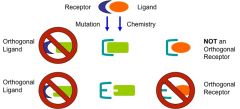![]()
![]()
![]()
Use LEFT and RIGHT arrow keys to navigate between flashcards;
Use UP and DOWN arrow keys to flip the card;
H to show hint;
A reads text to speech;
10 Cards in this Set
- Front
- Back
|
Many cellular proteins (like kinases) have similar ligands
|
We wish to achieve selective activation or inhibition
|
|
|
Orthogonal ligand-receptor pairs
|

Modify both receptor and ligand to increase specificity
|
|
|
Requirements for constructing an orthogonal receptor-ligand pair
|
-Structural information about binding site.
-Receptor must tolerate modifications. -Ability to synthesize orthogonal ligand. If the native ligand is endogenous, then the receptor also needs to be orthogonal. |
|
|
How to make an orthogonal ligand/receptor
|
Manipulate charges
Alter H-bonding patterns Introduce steric interactions (bump-hole) ~altering affinity is a concern with all methods |
|
|
manufacturing orthogonality via charge manipulation
|
1) Charge reversal
2) Removal of a charged interaction 3) Introduction of a new ion pair |
|
|
Example of "bump-hole" method for kinases
|
Many kinases are phosphorylated by ATP
-synthesized "bumped" ATP (add group to adenine) -create "hole" in kinase of interest |
|
|
Limitation of "bump-hole" method in ATP/Kinase example
|
“Bumped” ATP analogs cannot enter cells. Thus, cannot identify targets in vivo.
New strategy: use “bumped” cell-permeable kinase inhibitors to allow study of kinases in living cells (Next week’s paper). |
|
|
A transcriptional regulatory application
|

|
|
|
Advantage of "bump-hole" method
|
Bump-hole approach retains temporal control of small molecules while increasing specificity
|
|
|
Disadvantage of "bump-hole" method for therapeutic purposes
|
Limited direct application to treatment of disease due to requirement for mutation
|

